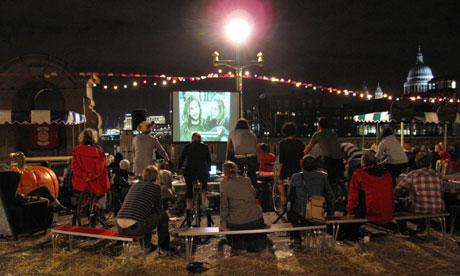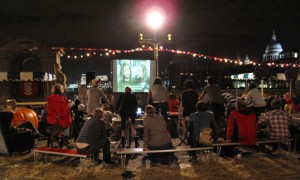Imagine how a a love of cycling might be combined with a British version of the great American drive-in cinema screening. . Welcome to the outdoor cycle-in cinema, where people rock up on their bikes, and connect them to a generator that powers the show.
The UK’s first cycle-in cinema appeared at The Big Chill in 2007, provided by Magnificent Revolution, a collective of about 10 engineers, artists, and environmentalists. Since then, screenings are popping up at festivals and in arts spaces all over the country. Check out Manchester-based Pow Wow Pedal Power, Bristol’s Spoke ‘n’ Chain, The Bristol Bike Project and Electric Pedals, which has taken cycle-powered cinemas to Brighton, Womad and locations around London.

On Sunday night I went to see – and participate in – a bicycle-powered of The Princess Bride at Hackney city farm, London. A stable of 12 bicycles in a field were hooked up to the projector and speakers, and set up to the sides of a large open-air cinema screen. You can bring your own bike to these events, but only the skinny-wheeled kind is suitable to be used in the generators – I was told my mountain bike tyres would make too much noise in the brackets.
Early on, people started piling in to sip wine and scoff vegan curries sitting in giant inflatable donuts or on picnic blankets, and before long someone gave some quick instructions and the first batch of human electricity generators hopped on the bikes. There are very few rules involved in the cycle-in cinema. They are: don’t spin the wheels, don’t cycle backwards, and lift your hand if you want someone to swap in for you.
Adam Walker, one of the organisers from the collective Magnificent Revolution, described how the cycles were able to power the event:
“As people start pedalling they turn the back wheel, which in turn is then turning a DC [direct current] motor backwards. The principle is that any motor that you turn backwards becomes a generator. This produces a DC current, which flows into a large ultracapacitor. This is kind of like a battery, but it holds charge for a limited period of time, smoothing the flow of the current to the inverter and then to the projector and the sound system.”
Each cyclist generates about 50 watts, which is enough to light up a low-power incandescent lightbulb. The projector and sound system on Sunday night were using around 400W. In theory you could get away with eight cyclists, then, but Walker explained that having 12 bikes made it easier and meant swapping in did not risk interrupting the film.
Indeed, the discreet whirring of pedal power made for a smooth viewing experience, apart from a couple of crackles in the sound. But in this festival-like and giggly atmosphere – with 160 other people swooning over the protagonists, enjoying the action, and quoting lines from the film – a few minor technical blips didn’t make much difference.
It turns out that The Princess Bride was a good choice of film for the event in more ways than one. “It needs to be quite fast-paced so people keep the momentum up. If you wanted to show a German expressionist film it just wouldn’t work,” Walker said.
Caught up in the ambience of epic adventure, I took my chance to replace a flagging cyclist. Being part of the cycling pack there was a sense of camaraderie and the pleasure of contributing to the evening. The pedalling felt slightly uphill and feeling of resistance varied depending on how much electricity I was generating and how many people were cycling. Also, bass frequencies make the sound system take up more electricity than high ones.
Cycling isn’t the most efficient way to generate electricity, however. It may not even be as low-carbon as you might expect, depending on what the cyclists have eaten. But Walker proposes that the cycle-in cinemas and Magnificent Revolution’s workshops in schools are a great educational tool to promote an awareness of electricity. The hypothesis goes: electricity is invisible and it is easier to value if you experience it in a visceral way. The cycle-in cinemas can also promote the joys of cycling to the uninitiated in an safe and stable environment.
So what might a people-powered future look like? Will we be enslaved on our bikes, like hamsters in balls, as ludicrously opined in one 2009 episode of Bang Goes the Theory? I very much doubt it.
But there does appear to be potential for a practical application of the concept in human-driven gyms. Such gyms already exist in Portland, Oregon and Hong Kong. It seems silly we are not already powering the lights in the gym when hundreds of people are already expending energy on rowing machines and fitness bikes.

 Follow
Follow